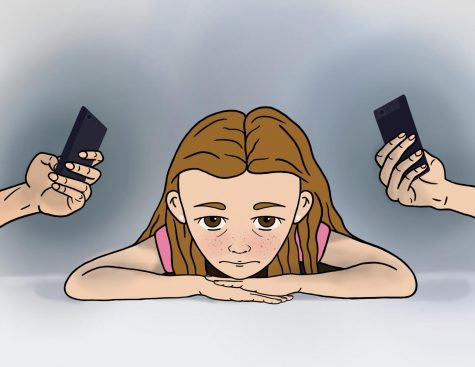Technological Tug-of-War
The Rift Created Between Teens And Parents Is Growing Due To Technology
February 24, 2020
Kai Schwemmer’s parents were quite strict when it came to technology as he began his high school years. Video games and social media access were limited to an hour. His phone turned off before 10 pm. To his parents, this seemed like the most logical way to regulate his technology use. But in a world where technology is not only part of society, but part of people as well, how are parents supposed to balance technology with their children’s need for communication and social connection?
“I fought for a long time with my parents, obviously from an issue of perspective,” Schwemmer, a junior at Highland, said.
There is a noticeable rift between parents and kids, especially teens, when it comes to technology that usually comes from different perspectives, childhoods, and expectations.
This tug -of-war between parents and teens has created plenty of tension between families. Parents are always acutely aware of the well-publicized dangers that technology brings, but teens worry more about the social ramifications of not being connected. On top of that, with the constant growth and change of our technological world, parents will often feel uncomfortable because they can’t keep up.
“Just because things are always changing, I think there’s always some tension,” Ines Schwemmer, Kai’s mom, said.
As early as 1929, when new technologies began to emerge in the world, authors of Middletown (a book on American culture) were already noting “the swiftly moving environment and multiplied occasions for contacts outside the home are making it more difficult to secure adherences to established group sanctions.”
Parents grew up in a world nearly free of hand-held portable technologies. Although humans like to try and be open minded to change, it is always hard to adapt.
“Especially if you’re younger, we often forget that people did live without phones. Everybody is like; ‘well the boomers are all anti-phones’, but I believe the kids are just as bad in the opposite way,” Schwemmer said.
Knowing both sides of this “war”, the fears, desires, and opportunities, might help alleviate some of the tension between families.

As the tech world grows, so does the seperation between kids and parents.
Communication:
It’s true, people did live without phones once upon a time, and while this technology has brought new ways of communication and connection that don’t require bikes or landlines, it is this very advancement that has also damaged the old ways of communication.
Children, more than ever before, are anxious and socially awkward, unable to communicate unless they’re doing it over the phone.
According to researchers at San Diego State University, after examining national statistics on social media use, depression, and suicide-related outcomes in more than 500,000 13-to-18 year olds, teens who spent more time on smartphones and social media reported more mental health issues. However, those who spent more time on non-screen activities like face-to-face interactions, sports, and religious services reported fewer.
This anxiety and depression leads to isolation and loneliness. Sure, children can make plenty of friends online, but there is a lack of human connection that many believe is okay to substitute with the overall connectivity that technology brings. More than 94 percent of social media-using teens say they spend time with friends on social media, but roughly 77 percent agree people are less authentic and real on social media than they are offline.
“When you talk to someone in real life, you get a very good sense of how they are and how compatible you two are but over text everything is more calculated and there’s an entirely different language to text. It is a language in itself,” Schwemmer said.
Dangers:
On the opposite end, parents are also being affected by the ever growing technology dependency. That hard to swallow pill of change can still be difficult to get down when parents are watching their kids and the dangers that they face on the internet. Parents are like mamma bears, willing to let their cubs explore, but not too far where they can’t jump in and help at any sign of danger. While parents don’t always understand why kids want to be on social media so much, they do understand how dangerous that social platform can be.
“Parents want to protect their kids, so a lot of the time it’s about trust versus control,” Ines said. “There has to be tons of trust. I know Kai feels like there’s a lot of control but from a parent perspective, there’s so much trust that you [teens] will figure it out.”
Almost all parents fear for their kid’s safety, which is already at risk in the real world, but when a teenager can get online and have access to people, places, and information all over the world, that fear only gets stronger. This circles back around to the lack of authenticity online. While kids may understand technology better than their parents, they are still learning.
“When it comes to social media, or access to sites that are not really appropriate for their developing mental stage, I absolutely think it can be dangerous,” Ines said.
Kids make mistakes; they are often trusting and easily fooled, not just by people but by information, and it’s easy for them to feel powerful online. On top of that, even if they know the people online, 47 percent of teens have received intimidating, threatening or nasty messages online.
On apps like Tik Tok, Snapchat, and even on video games, sexual predators are finding new ways to lure in kids. When parents read articles about these emerging dangers and hear about kids getting tricked online, they immediately disregard the social connection side of technology.
Upbringings:
Both sides of this rift are seeing their own downsides to advancements presented to them, but both believe that the upsides are far more important than not only the down of their own side, but the worries of the other side as well.
“It is such a different world, and looking at technology and how it’s progressed in the last 10 years in comparison to the last 100 is absurd,” Schwemmer said. “It’s gone nothing but exponentially up.”
Looking at that growth, there was the industrial revolution, creating a technological dependency for the first time. From there, the computer was born and very much changed things for the world that parents grew up in. Parents don’t usually get upset over their kid emailing too much, not just because email isn’t as popular, but because it is familiar territory.
“They had email, they understand email. You’ll never get a parent complaining that their kid is spending too much time using the internet in a way that they find acceptable. That is the important thing. That’s why parents and kids fight,” Schwemmer said.
Parents and kids have an equal understanding of acceptability, and while the things that they find acceptable are often different, both have that shared ground. This is very much what has shaped the rift itself. Both parents and kids are affected by what they grew up with and what they saw. Kids expect a certain leniency from parents and parents worry for their kids safety to the point where they don’t trust them at all.
“I think some kids are more up to learning how to manage it [technology] and other kids are less so, so it makes it tricky to negotiate,” Ines said.
Schwemmer believes that kids are the tests, they are the trial run of technology and that it’s being very dangerously handled.
“I think too many kids hate their parents for getting mad at them so they estrange themselves from their parents because their parents are fighting against the phones and technology,” Schwemmer said. “The ultimate problem is parents fight against technology because it’s foreign and because it is actually harming the children but it’s difficult to fight against something that is necessary in our society.”
The Solution:
Schwemmer believes that there is no solution.
Technology is going to keep advancing and there’s absolutely nothing people can do to stop it. It’s going to be generational and it’s going to become a problem that parents are almost always going to disagree with.
“I always tell my kids, let the device be your service or servant, not your master. That’s the ultimate goal and to achieve that, it’s probably much more individual than we think,” Ines said.
Eventually, when kids grow up, they might also have problems with their era of technology because it is ever changing, growing, and dominating.
Ines thinks that whatever solution there is, it’s impossible for it to be a black and white answer.
Looking at this growth and how it is expected to continue, it is unrealistic to tell kids they shouldn’t have phones, that they shouldn’t communicate and socialize.
“If you do say that, you have to let all of your life revolve around that decision. There’s not a halfway on the issue, you either need to avoid it completely or learn to moderate yourself,” Schwemmer said.
According to Schwemmer, it comes down to parents and kids having a crucial conversation, and it comes down to understanding each other. However, both sides need to go into this conversation knowing they are not going to get the perfect results, and this becomes the new issue. Now, there is the struggle with authority, which is where humans will always struggle.
“It is very much a flexible issue, it’s not static, which is the issue because a lot of the ways we think about it should be static,” Schwemmer said.
The growth of technology and its influence is still in the trial run. People have never had this happen, so there is no answer, but that doesn’t mean the growth and the rift will just stop.
“A parent will never ever be able to force a child into doing what is right. They may be able to do it temporarily, but a child through their parents deciding what is right is not going to be as valuable as the child deciding for themselves what is good,” Schwemmer said.
It comes down to communication. Not texting, or social media, or even email communication. It comes down to the basic human talking, setting boundaries. Not to seal the rift between people and technology, but to seal the rift between each other that technology can create.






























